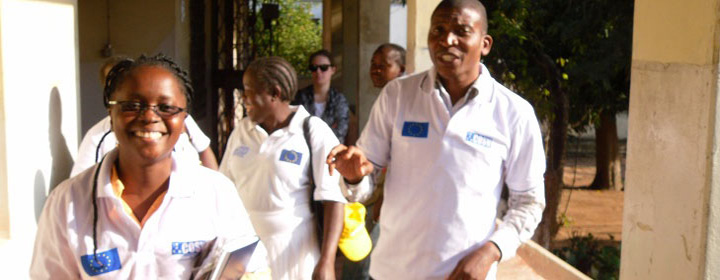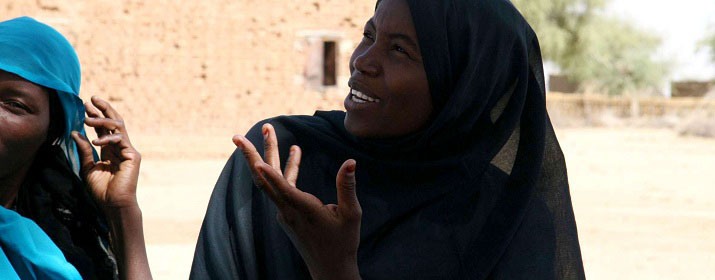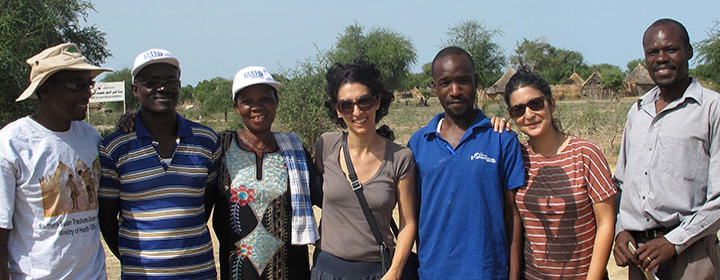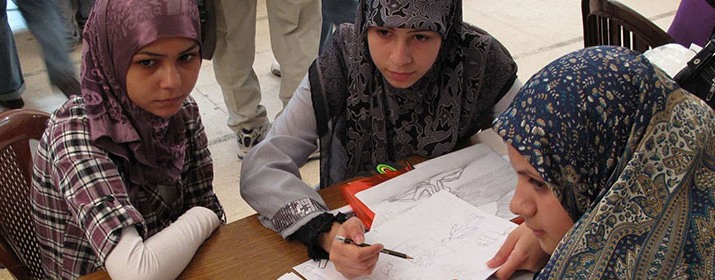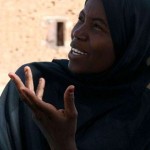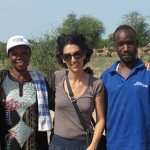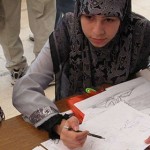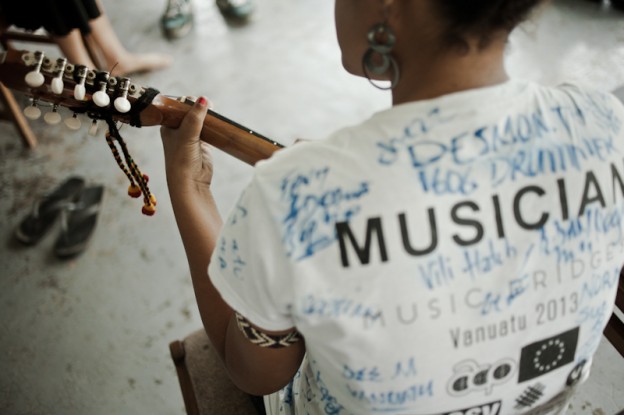A workshop on free licenses and copyright in music careers – written by Cristina Perillo
Creative commons and the author’s intention
“The basic idea of Creative Commons is that the “all rights reserved ” automatic rule, that governs copyright automatically and up to 70 years after the death of the author, is not always and no matter how what the author wants. Not all authors are always interested in prohibiting to anyone, except their publisher, to do anything with their works. On the contrary, many – especially amongst the creative people who use Internet as a means of finding inspiration and co-workers, deal with others and spread their work – prefer a more flexible approach, in which only some rights are reserved. Not surprisingly, there is often a talk of “some rights reserved” licenses, with some rights automatically granted to the rest of the world, as long as the conditions of the license are complied with. So, on the one hand Creative Commons are a generalization of the legal instruments (licenses) to any creative work, created to foster collaboration amongst creators of free software, on the other hand they are part of a wider debate that highlights how the legislation on copyrights needs updates, in order to seize the opportunities offered by the digital revolution”.
The steps described by Federico Morando, director of Creative Commons Italy, on the authors’ intentions in regards to the accessibility and use of their work, have been the starting point to design a workshop on Creative Commons licenses and music, realized last October in the Republic of Vanuatu, during a residential camp for musicians within the Music Bridges project. The points touched by Morando presuppose a knowledge of the principles of copyright, awareness of one’s rights on works conceived and produced in first person and duties on works designed and manufactured by others, the perception of one’s role as author, in this specific case as musician, that is also a role of cultural mediator and vehicle of knowledge of great value and social impact.
lettera27 and Music Bridges
Music Bridges is a project that aims to strengthen the creation and production in the field of the music industry in Vanuatu and Mozambique, implemented by COSV Milan – a NGO active in projects in Africa , Latin America, Asia and Europe – in collaboration with a network of international partners, including Lettera27 Foundation, a non- profit organization founded in 2006 with the aim of supporting the right to literacy and education and access to knowledge, with a geographic focus on Africa. The involvement of the foundation in Music Bridges project aims to create a network of speakers and expertise on free Creative Commons license, able to effectively communicate with the protagonists of the creative music industry. As project manager of the foundation, in 2012 I’ve received the proposal to enter into Music Bridges project. We’ve welcomed the invitation, unaware of the wonderful mess in which we were getting into.
Which workshop and for whom?
Singaot Musik Kamp in Vanuatu is a two-week sojourn that involves about 80 musicians, producers and managers of the creative music industry and non-profit sector, from a dozen countries. The program consists of workshops on music improvisation, live performances and jam sessions, and workshops on copyrights, protection and sharing of traditional and contemporary music as cultural heritage with a strong social impact.
The first week is all about musical improvisation to learn new traditional and contemporary sounds, with musicians and expertise from different areas of the world. It’s a learning by doing approach: musicians know each other and learn to work together without filters, directly through the language of music. They exchange instruments and sounds of the respective countries and realize together a new song that will be part a special collection made and distributed on CD by Music Bridges.
During the second week, participants have the opportunity to perform live in Fest’Napuan Music Festival. The event annually attracts about 40,000 people and it’s one of the most important events in the cultural agenda of Pacific Islands. The participation of Music Bridges musicians permits to the event to take an international dimension. At the end, days are scheduled on three theoretical workshops.
The workshops I’m coordinating is dedicated to the introduction of Creative Commons licenses and it’s addressed not only to musicians but also to producers and managers of the cultural organizations partners of the project, that are primarily concerned with development, training and distribution in the field of music. The meeting is designed and carried out with SooHyun Pae, regional coordinator of Creative Commons Asia and Pacific, and with the contribution of the lawyer Miranda Forsyth, specialized in copyright in the Pacific.
The arrival in Vanuatu: thinking the workshop
The arrival in Port Vila shows me that the target of the participants is not homogeneous; awareness about their role as enablers of social and cultural cohesion, the rights on their work and their image, the possibility of expanding their network and of distributing their products through a combination of management and marketing principles are at very different levels. The basis for any possible reflection on this issue often lacks. In fact, the essential aim of copyright is not always clear.
The purpose of copyright is to allow the author to elicit all the economic benefits that arise from the proper exploitation of his/her work” – says the lawyer Massimo Maggiore, an expert in intellectual property law that supports lettera27 with its pro bono consultancy – Listening to music in a public place is in itself a simple and usual act, of a relationship-wise culture, but implies that the author and performer of the song have created an asset that enriches a moment of social life, which makes it nice go to that place and creates value for all. The law takes the view that it is right that the author enjoys the fruits of those positive externalities, and therefore it has established the right to an equitable remuneration for this form of exploitation.”
What should be done first is to explain Creative Commons as “a movement that starts from the idea to recover one of the original purposes of the copyright law, that is not only controlling but also encouraging (with the consent of the author) the circulation of ideas and works through the Internet” – as Maggiore explains. “Today, any work arises with the “armor”: for the simple fact that it was somehow externalized, it benefits the full copyright protection”.
So even if an author is not known, or he/she is simply disinterested in keeping his/her work exclusive and he would like to allow the free use for anyone, he/she just could not do it. The default schema of the law is “all rights reserved”. The CC movement stems from the need to overcome this scheme, through the coding of general license schemes that overturn the assumed normative: only some rights are reserved. This opens up a range of possibilities that goes from the broader formula of the sole attribution to the more restrictive choice that allows only non-commercial use and prohibits the creation of derivative works. “It is done! Once these basic points have been introduced to an audience that knew little or nothing about copyright, the debate switched on: the participants shared questions, thoughts and personal experience and three particularly relevant cases gave an immediate response to the objectives of our workshops. They made us realize that we have hit the target”.
The musician: while managing the copyright, it’s better with a band than as a solo
Ni-Vanuatu musician and composer, actively committed with Further Arts – an association located in Port Vila and partner of Music Bridges project, Marcel Meltherorong is a reference point for musicians in a system where there are no labels, or production houses and professional recording studios. Vanuatu music market is in fact based on self-publishing and unconsciously and tacitly authorized piracy. Here music is not a paid job, except when it’s in close relation with tourism and if part of the traditional mold, which tells of the roots of these islands but not of the current dynamics, of contemporary social problems, of love, friendship, feuds and, in short, of everyday life.
Through his music, Marcel is working on the awareness of a possible social impact of music, a possible acknowledgment of authorship, a possible music market. During the workshop, his interest focuses immediately on the possibility of founding an association of collective management for musicians, on the model managed and presented by Somas. For Marcel, in this future association a piece of work on licensing and Creative Commons could be included, thanks to the skills that will be made available by the Creative Commons affiliate network in the Asia and Pacific region. Some affiliate, in fact, already play information, training and mentoring activities for musicians and music schools, and have it in their programs initiatives that may be suitable for a collaboration with the organization that Marcel has begun to imagine. SooHyun Pae, acting as coordinator of the area, is the person who can sort the right connections and collaborate on a suitable program.
The producer: they stole my music? Next time I’ll give it for free
Luciano Mabrouck is the founder of the MaronRprod, a production house well known in La Réunion that produces and internationally distributes renowned artists. During the workshop, he reacts with a story that puts into clear light the power and potentiality, even commercial from his point of view, of sharing music without direct profit purposes. He tells us that Kaf Malbar, a well-known and loved singer in La Réunion, managed and distributed by MaronRprod, lost the demo of his new album.
His songs were immediately distributed illegally online, they were on all mobile phones, around the streets, and DJs played them on the venues. Trying to block, or even just to contain this process, either than clearly useless with respect to the mechanisms of the web and the local network, it would have be detrimental to the musician, who would have risked a negative reaction of his audience. Leaving the songs uncontrolled, the artist began to work on new songs: he came out with a double CD, which included the old looted songs and new ones, and it has been the biggest commercial success of Kaf Malbar that established his ultimate success at national level: those who had already loved the illegal songs now want more than ever to listen to the new ones and have the CD, the artist’s fetish.
As a result of this experience, the artist has created a one year project: 15 songs available for free download on his official website, one (or two) per month. The result ? Next to the expected large number of downloads, an exponential growth of requests for performances and concerts .
And what if a Creative Commons license had been applied to the released tracks, so that the metadata would have made the songs easily found on the web even by those who, while not knowing the artist, were looking for music under Creative Commons? Would this have led to a widening of his audience?
The manager: entering the network of Creative Commons affiliates
Manager of festivals, of Music Crossroads Mozambique – a non-profit organization based in Maputo and project partner, of a Music Academy born last May, and Professor of Arts Management at the University of Maputo, Rufus Makuleve works since ever in music promotion and distribution. The academy, founded in May, has now a first class of 20 students: in their first year, they will face a course of study lasting three and containing two different career opportunities – musician or music teacher. There are no music schools in Mozambique that certify that the professionalism of those who teach music.
Those who usually work with music often don’t have an academic background that allows them to teach music in schools. The Academy aims to get the Government public recognition for the certification of its graduates, in order to enable them to work as teachers, thus contributing to the professionalization of the musicians and the training of music teachers for other schools, from primary schools on. The Academy, designed on Rufus and Music Crossroads’ methodology, is the first pilot project which will be replicated in other African countries, starting from countries where Music Crossroads network is already present.
The day after the workshop, during a meeting with me and SooHyun, Rufus asked us a lot of additional information and specifications, compared to the ones we had been able to introduce during the training, about the Creative Commons network and the relations – hierarchical, organizational and of information and training – between headquarters and local affiliates offices. In Africa there are only five Creative Commons affiliated and Rufus is thinking about the opportunity to open an office in Maputo and then work, according to his usual method, on the Music Crossroads network for the replicability of the model. The embryonic idea, after a long chat, is to do this process within Music Crossroads association.
Rufus explained us that in Mozambique there is no awareness about copyright in the music field, at any level: neither as authors’ knowledge on the rights they hold on their work, neither as a tool to distinguish what is lawful and what is not when you reuse, remix and distribute the work of others. “It’s urgent to address this issue and bring it to the attention of the music industry,” he says, “I can give you an example, it’s about the latest musical genre that recently has strongly developed in Mozambique: it’s called Pandza, and it’s the most popular genre among young Mozambicans. It’s a mix of Marrabenta, Reggae and Hip Hop, that uses existing songs to talk about the daily life of kids in Mozambique. The songs are performed by mixing samples and songs illegally downloaded from the Internet, and used again in an illicit way. Other than issues relating to moral rights, the first ones every artist must be aware of, what will happen when someone becomes rich and famous thanks to a song created with the work of someone rich and famous enough to cause him or her serious legal troubles?
Conclusions
Considering the level of new knowledge that had been shared with the participants in Vanuatu and thinking about how the workshop had profoundly changed since its first ideation to its final realization, it comes to my mind the electric light, brought up by Mashall McLuhan as an example of information in its purest form, of medium without message. On the contrary I realize that the Creative Commons system, and even before the Creative Commons brand, is both the instrument and the message, that bases its dual nature of medium and content on still unfamiliar, as well as for many verses obsolete, intellectual property and moral rights principles, even before the commercial exploitation of intellectual and creative work.
McLuhan based the discourse behind his famous essay The medium is the message of Understanding Media on an example familiar to any reader. He harked back to an example of an already happened and consolidated access to knowledge, that is the knowledge of the electric light, already experienced in first person by any reader of his book.
Today I’m more and more aware of the fact that things are not so when talking about copyright law: there is no knowledge even within those who possess it, that are the authors themselves. This renewed awareness convinces me of the urgency to bring to light this issue – even before deepening into it – in the most varied fields of action and to very different levels of professionalism. Together, it confirms me the necessity and importance of continuing to include workshops, discussions and initiatives that educate and disseminate knowledge that can help to build new and deeper levels of awareness on the issue in broader contexts, and capable of reaching specific targets, diversified per disciplinary and operational matters, literacy and professionalism level.
Article by Cristina Perillo for lettera27, a non-profit foundation born in July 2006.
Interviews with Massimo Maggiore, lawyer expert in intellectual property law, and Federico Morando, project leader of Creative Commons Italy, are by Massimo Randone. The article is released under CC BY-SA.

